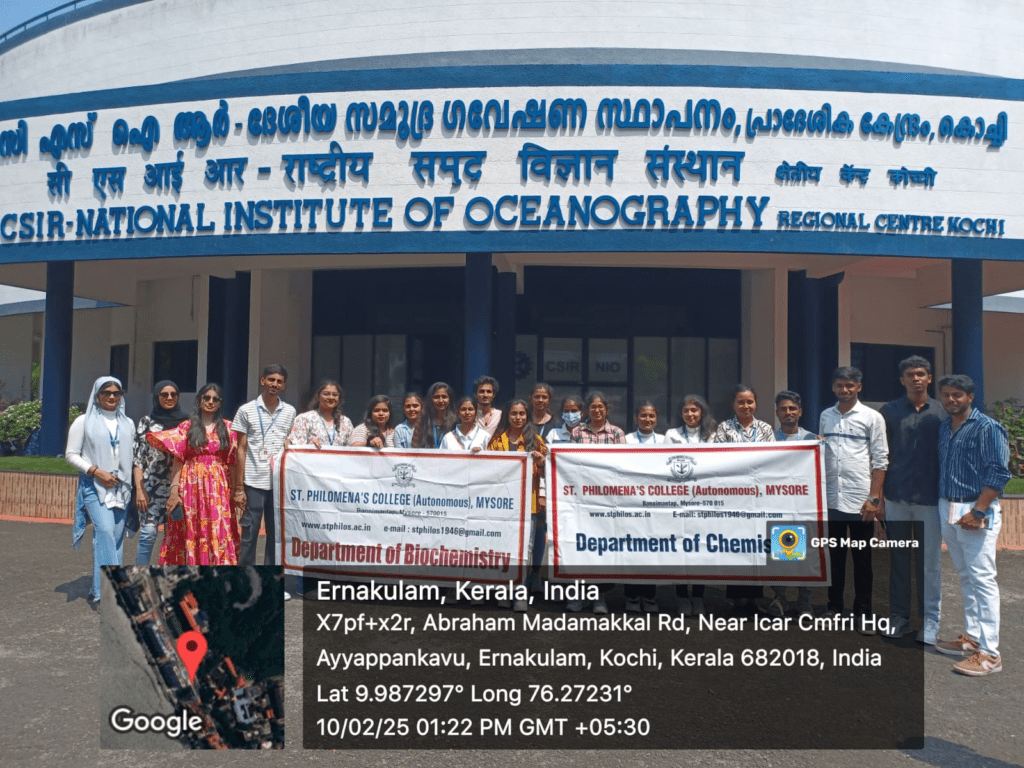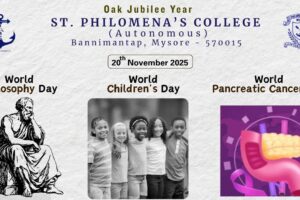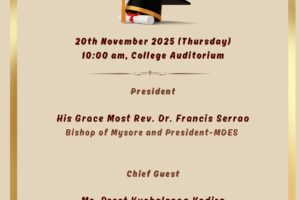
Industrial Visit to Kochin
Date: 10- 12th of February 2025
Place: Kochin, Kerala
No. of Participants: Students: 21
Staff : 04
Introduction: An industrial visit plays a crucial role in bridging the gap between theoretical knowledge and practical applications. As part of our academic curriculum, students from the Department of Chemistry and Biochemistry embarked on an educational tour to Kochi to explore various industries and research institutions

This report presents an overview of our insightful journey, which encompassed visits to the Travancore Cochin Chemicals, BIONEST, National Institute of Oceanography.etc.
The study tour for 2024-25 batch of Physics-Chemistry, Chemistry-Zoology and Chemistry- Food Science & Nutrition, with 21 students was held on 09/02/2025 -13/02/2025 accompanied by 4 staff members. The journey began from Mysuru to Ernakulam, Keral by Tirunelveli express at 12.30 PM and reached Ernakulam next day morning at 4:30 AM.
Objectives of the Visit
- To gain practical exposure to industrial processes in the fields of chemistry and biochemistry.
- To understand the working mechanisms of chemical manufacturing units and research institutions.
- To observe quality control and environmental safety measures in industrial settings.
- To interact with industry professionals and researchers for knowledge exchange and career guidance.
- To comprehend the role of industrial waste management and sustainability practices.
- To enhance awareness of potential career and research opportunities in chemistry and biochemistry.
Day 1:–10-02-2025 Industries Visited

1.Travancore Cochin Chemicals (TCC) Travancore Cochin Chemicals is a major chemical manufacturing company specializing in the production of caustic soda, chlorine, hydrochloric acid, and sodium hypochlorite. The visit provided students with a comprehensive understanding of large-scale chemical production processes, safety protocols, and industrial waste management techniques.
Production Units:
i)Caustic Soda Production Unit: Students gained insights into the electrolysis process that separates sodium hydroxide, chlorine, and hydrogen.
ii)Chlorine Processing Unit: This section explained how chlorine gas is liquefied and stored for industrial applications such as water treatment and PVC manufacturing.
iii)Hydrochloric Acid Unit: Demonstrations were provided on the synthesis and applications of hydrochloric acid in pharmaceuticals and other chemical industries.
iv)Sodium Hypochlorite Unit: This segment highlighted the production of bleaching agents and disinfectants, showcasing their importance in public sanitation and water purification.
v)Waste Treatment Facility: Students observed how TCC manages industrial effluents and ensures compliance with environmental regulations.
Day 2: 11-02-2025 Time:9:30- 1:pm
Bionest Visit: Research Facilities and Technology Demonstrations
Bionest serves as a biotechnology incubation hub, fostering innovation and supporting start-ups in biosciences. The facility provides an ecosystem for entrepreneurs, researchers, and scientists to develop cutting-edge technologies in various domains such as bio-pharmaceuticals, agricultural biotechnology, and environmental sustainability.
Research Facilities and Technology Demonstrations
The visit included a tour of Bionest’s state-of-the-art research laboratories and collaborative workspaces, which focus on:
- Molecular Biology and Genetic Engineering Labs: Equipped with advanced PCR machines, gene sequencing tools, and CRISPR technology for research in genetic modifications and biomolecular studies.
- Cell Culture and Bioprocessing Units: Supporting research in biopharmaceuticals, including vaccine development, regenerative medicine, and stem cell research.
- Bioinformatics and Computational Biology Center: Utilizing AI and data analytics for genomic research, drug discovery, and protein structure analysis.
- Bioproducts and Bio-materials Development Labs: Focused on creating sustainable alternatives such as biodegradable plastics and plant-based biofuels.
- Environmental Biotechnology Unit: Engaged in wastewater treatment solutions, bio-remediation techniques, and microbial fuel cell research.
Technology Demonstrations:
During the visit, students observed hands-on demonstrations of emerging biotechnological applications, including:
- 3D Bioprinting: A demonstration of how living cells can be printed into tissue structures for medical research.
- Biosensors for Rapid Diagnostics: A startup showcased a portable biosensor that detects pathogens in water samples within minutes, revolutionizing water safety testing.
- Microbial Fermentation Techniques: Students observed the production of bio-enzymes used in industries like food processing, textiles, and waste management.
- Precision Agriculture Technology: A demonstration on biofertilizers and plant growth-promoting bacteria for sustainable farming.
- Synthetic Biology Applications: Insights into how engineered microbes are being used for biofuel production and environmental cleanup.
The visit to Bionest provided students with a deep understanding of how biotechnology is shaping the future, inspiring them to explore research and entrepreneurial opportunities in the field.
National Institute of Oceanography (NIO)
Time of visit: 2:30 – 4:0pm
The National Institute of Oceanography (NIO) is a premier research institute dedicated to the study of marine sciences, focusing on oceanographic research, climate change, marine biodiversity, and coastal ecosystem conservation. The visit provided students with insights into various aspects of oceanography, including marine chemistry, biological oceanography, and environmental sustainability.
Research Facilities at NIO
During the visit, students were given an overview of the institute’s specialized research divisions and laboratories:
- Marine Chemistry Laboratory: Focuses on seawater composition, pollution assessment, and the impact of industrial waste on marine ecosystems. Researchers explained how heavy metal contamination and oil spills are analyzed and mitigated.
- Biological Oceanography Unit: Studies marine biodiversity, plankton ecology, and the biochemical properties of marine organisms for potential pharmaceutical applications.
- Coastal and Marine Geology Lab: Investigates sediment transport, coastal erosion, and underwater mineral resources, providing insights into sustainable marine resource management.
- Marine Biotechnology Lab: Engaged in discovering bioactive compounds from marine microorganisms, seaweed cultivation, and applications in drug development and cosmetics.
- Climate and Ocean Modelling Center: Uses advanced computational models to predict climate change effects on ocean currents, sea level rise, and monsoon patterns.
- Underwater Exploration and Remote Sensing Facility: Demonstrates the use of sonar mapping, satellite imaging, and autonomous underwater vehicles (AUVs) for deep-sea research.
Technology Demonstrations and Observations:Students witnessed various oceanographic research technologies in action:
- Water Sampling and Analysis: A live demonstration of how oceanographers collect seawater samples at different depths to study salinity, pH levels, dissolved oxygen, and nutrient content.
- Plankton and Microbial Analysis: Observation of marine plankton species under high-resolution microscopes, with discussions on their role in the marine food chain and carbon cycle.
- Deep-Sea Exploration Equipment: Presentation on remotely operated vehicles (ROVs) and their role in exploring the ocean floor for scientific and commercial applications.
- Marine Renewable Energy Research: Insights into wave and tidal energy potential, including prototypes of devices harnessing ocean power for sustainable electricity generation.
- Ocean Pollution Monitoring Systems: A demonstration of how real-time sensors and satellite data are used to track oil spills, plastic waste accumulation, and coral reef health.
The visit to NIO was an eye-opening experience, providing students with a greater appreciation for ocean science and its role in addressing global environmental challenges.
Day-3 13-02-2025
Sight-seeing in Kochi: A Blend of History, Culture, and Scenic Beauty
Kochi, known as the “Queen of the Arabian Sea,” is a vibrant coastal city in Kerala that offers a perfect mix of history, culture, and natural beauty. From colonial-era landmarks to scenic waterfronts, here are some must-visit sightseeing places:
Mattancherry – A Blend of History, Culture, and Trade
Mattancherry is a historic and culturally rich neighborhood in Kochi, Kerala, known for its colonial influences, spice markets, and heritage sites. It is a must-visit destination for history lovers, art enthusiasts, and those interested in Kerala’s diverse cultural fabric.
1. Historical Significance
Mattancherry was once a prominent trading hub where merchants from across the world—Portuguese, Dutch, British, Arabs, and Jews—came for spices, textiles, and other goods. This has resulted in a beautiful mix of architectural styles, traditions, and communities.
2. Major Attractions in Mattancherry
Jew Town – A vibrant street lined with antique shops, spice markets, and handicraft stores, reflecting the influence of the Jewish community. The scent of cardamom, cinnamon, and pepper fills the air.
3.Paradesi Synagogue – Built in 1568, this is the oldest active synagogue in the Commonwealth. It features hand-painted Chinese tiles, Belgian chandeliers, and ancient Hebrew scriptures. The synagogue is a testament to the once-thriving Jewish community in Kochi.
4.Mattancherry Palace (Dutch Palace) – Originally built by the Portuguese in the 16th century and later renovated by the Dutch, this palace showcases Kerala murals depicting scenes from Ramayana and Mahabharata, royal artifacts, and portraits of Kochi’s rulers.
5.Museum (Hill Palace or Kerala Folklore Museum) – The Hill Palace in Tripunithura is Kerala’s largest archaeological museum, showcasing royal artifacts and paintings. The Kerala Folklore Museum in Thevara houses a vast collection of antiques, folk art, and cultural exhibits reflecting Kerala’s rich heritage.
6.Spice Markets – Mattancherry is famous for its spice trade, with numerous shops selling cardamom, pepper, turmeric, and exotic blends used in Kerala cuisine. The markets offer a glimpse into Kochi’s historical role as the “
Vallarpadam Basilica (National Shrine of Our Lady of Ransom)
History: Originally built in 1524 by the Portuguese, it was later reconstructed in 1676 after being destroyed by floods. In 1888, it was elevated to the status of a Basilica by Pope Leo XIII.
Special Features: Recognized as a National Shrine by the Vatican.It houses the miraculous portrait of Mother Mary (Vallarpadathamma), believed to protect fishermen and travellers.
St. Mary’s Basilica, Ernakulam.
Significance: One of the oldest churches in Kerala, the first Basilica in Kerala (since 1973)
History: Built in 1112 AD, it was originally a small church and was later reconstructed multiple times.
Special Features:
- Gothic-style architecture with tall spires and stained-glass windows
- A major place of worship for the Syro-Malabar Catholic community
Conclusion: Key Learnings from the Visit
- Understanding the chemical, biological, and geological aspects of oceanography.
- Gaining awareness of how climate change is affecting marine ecosystems and coastal communities.
- Learning about career opportunities in marine research, environmental monitoring, and biotechnology.
- Exploring the role of advanced technology in deep-sea exploration and sustainable ocean resource management.
- Observing real-world applications of chemistry and biochemistry in marine research and conservation.
- Each of these places offers a unique glimpse into Kochi’s rich heritage, spirituality, and scenic charm
Outcome of the Visit
The industrial visit to Kochi provided students with a valuable opportunity to bridge the gap between academic knowledge and real-world industrial applications. The key outcomes of the visit include:
- Enhanced Understanding of Industrial Processes: Students gained firsthand exposure to chemical and biochemical manufacturing, biotechnology incubation, and oceanographic research methodologies.
- Exposure to Advanced Research and Technology: The visit provided insights into cutting-edge technologies such as bioprocessing, genetic engineering, marine biodiversity studies, and deep-sea exploration.
- Awareness of Industrial and Environmental Safety Measures: Observing quality control procedures, safety protocols, and waste management systems helped students understand the importance of environmental sustainability in industries.
- Career and Research Opportunities: Interactions with industry experts and researchers broadened students’ perspectives on career paths in industrial chemistry, biotechnology, marine research, and environmental science.
- Inspiration for Innovation and Entrepreneurship: The visit to Bionest particularly encouraged students to explore biotech entrepreneurship, research innovations, and start-up opportunities.
- Real-World Applications of Theoretical Concepts: Students connected classroom knowledge with industrial processes, such as electrolysis in chemical production, bio-based material development, and the chemistry of oceanic ecosystems.
Conclusion
The industrial visit to Kochi was an enriching and insightful experience for the students of Chemistry and Biochemistry. The exposure to large-scale chemical manufacturing at Travancore Cochin Chemicals, the innovation-driven ecosystem at Bionest, the marine research advancements at the National Institute of Oceanography (NIO), and the historical insights at National Institute of Oceanography provided a holistic understanding of the diverse applications of their field.
Students were able to appreciate the dynamic nature of scientific advancements and industry demands. The visit not only strengthened their technical knowledge but also motivated them to explore new career paths, research opportunities, and entrepreneurial ventures.
The insights gained from this visit will serve as a strong foundation for their future academic and professional endeavors.



